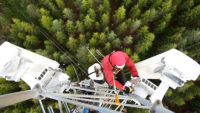The Z459.1 Rope Access Standard explained
Subcommittee chairperson discusses what it is and why it’s important

If you've ever seen someone washing the windows of a skyscraper or inspecting a bridge, you’ve witnessed an example of rope access work. The ANSI/ASSP Z459.1 standard, the first of its kind, establishes safety requirements for rope access systems. We spoke with Loui McCurley, chair of the ANSI/ASSP Z459.1 subcommittee, about rope access work, the Z459.1 standard and how it can help keep workers in these environments safe.
ASSP: Let’s start with the basics. What is rope access?
McCurley: It's an interesting term, because sometimes people assume that anything with a rope must be rope access. But that would be a little bit like saying anything with a fall must be fall protection. It's just not true.
Rope access is a method of fall protection that also involves providing access to a location. So, you have two separate systems: You have an access system and a backup system, and they're both ropes, and that's what constitutes a rope access system.
ASSP: What types of equipment are used in rope access work?
McCurley: There are two kinds of equipment involved in rope access: There's the equipment on your main line — which is your progress line — and that would be in place of your feet. That’s getting you to and from where you want to go. You have a descender, you have an ascending system with rope grabs or ascenders, and you have various lanyards and combinations of those that allow you to move up, down and sideways on ropes.
And then on the other side is your backup system. You have the secondary protection so that if something should happen and your primary system should fail for whatever reason that backup system would catch you. Now, that backup system is arranged in such a way that it limits the potential fall distance, thereby limiting the amount of potential force on the system as well. So, we don't need to have the extreme capabilities that a typical fall arrest system might have.
In typical fall arrest, we allow a 6-foot and sometimes even greater distance of freefall before the system starts to grab you. The distances and forces are higher than what you see in rope access. In rope access, we keep that secondary system no more than a couple feet away at any given time, and generally above our attachment points. So, the potential for a significant fall is mitigated. The equipment that we can use for that doesn't have to be quite as extreme as the conventional fall arrest equipment.
ASSP: Rope access work sites are classified into two categories: simple sites and complex sites. What are the differences between the two, and how do you plan before working at each type of site?
McCurley: Simple rope access is defined as a rope access site or location where there is both top and bottom egress and access to the rope, and so the technician can get on and off rope at both locations. In a simple system, there is not extensive sideways deviation of the rope.
I'll use bridges is an example: When a bridge engineer is doing bridge inspection, typically they'll descend to a certain point, but then their next anchor might be 20 feet over to one side and so the rope will go down and have a belly in it and come back up and be re-anchored at that location 20 feet off to the side.
There are ways to safely negotiate that without creating a swing fall hazard, but that's a more advanced skill, so we call that complex rope access. For complex rope access, the technicians need to have additional training, additional skills and additional proven capability of techniques so that they can negotiate that safely.
ASSP: Why did the ANSI/ASSP Z359 Fall Protection Committee develop this standard?
McCurley: We are focused on fall protection as a whole. But one of the gaps that Z359 has had since its inception is acknowledgement of rope access. Z359 has focused on fall arrest, positioning, restraint. People who are doing rope access have tried to squeeze themselves into one of those definitions. They don’t really fit because there’s some specific requirements around fall arrest.
When using a rope system, it was assumed that you needed to have conventional fall arrest, which involves 6-foot lanyards, long fall potentials, dorsal attachments and things that just don't really work when you're using a rope as your main line.
Z359 recognized this many years ago, but we didn’t wrap our heads around it or address the need for further definition until after the publication of the ISO 22846 rope access standard. I think that was the first time that the Z359 committee looked at it and said, here's how rope access can integrate with and not necessarily bump heads with conventional fall protection.
ASSP: What do you hope users take away from the Z459.1 standard?
McCurley: My greatest hope is that this standard will make rope access more accessible to a broader range of people. Right now, the people using rope access tend to be specialists. They're highly advanced, skilled — and it's used less than it should be, in my opinion.
By opening rope access to a broader spectrum of workers and work types, I think that we can improve safety for people just by giving them a way to do their work. The Z459.1 standard has everything:
- Program management for supervisors and employers
- Equipment selection and rigging for qualified people
- Inspection of rigging and techniques for competent people (including rescue)
- Methodologies for authorized people
The fact that the standard covers so many different aspects of rope access might seem like a lot to dig through and to wade through. The reality is that understanding each other's limitations, roles and responsibilities helps everyone work more effectively. Having it rolled into one standard is beneficial.
Looking for a reprint of this article?
From high-res PDFs to custom plaques, order your copy today!








